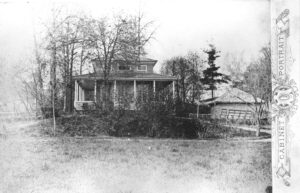History of Loviisan Kappeli
Built in the reign of Alexander III to its full splendour, the Chapel served the guests of the then Loviisa Spa, offering a place to relax with punch and health waters on its open-air terrace. The gentry strolled through the beautiful park.
The park with its fountains is a remnant of the planned Loviisa Fortress, which was planned as Finland’s easternmost defence after Hamina was ceded to Russia at the Peace of Turku. The park still has earthen ponds and the existing pond as a moat. Other parts of the fortress in Loviisa include the Ungern and Rosen bastions and the Svartholma sea fortress, the Komendant’s house next to the chapel, which now houses the Loviisa Museum, and the barracks.
Like the city of Loviisa, the chapel’s heyday was in the late 19th and early 20th centuries, when German and Russian tourists, among others, were attracted to the Loviisa Spa and found accommodation in the homes of Loviisa residents. During the day, spa guests enjoyed treatments and in the evening they ate, drank and partied in the Chapel. The word Kappeli apparently comes from the Swedish word kapellet, meaning a band.
In 1946, the chapel was renovated and the open porch was covered in order to create more interior space. From the 1960s onwards, Kappeli became the centre of East-Eastern Finnish entertainment and almost all the famous Finnish artists performed there, and many a love story was born, such as stories of school-leaving parties and celebrations of May Day and Mother’s Day. As the 2000s approached, Kappel’s activities dwindled and, with a change of owners, the maintenance of the property was poor until 2005, when Kappel ceased to exist altogether.
Airi Kallio, a master restoration painter, had seen the poor condition of a building of cultural and historical value and a Special Protection Area, and it did not leave her alone in her thoughts. Eventually, he made the decision to buy the building and restore it to its 19th century splendour. The deeds were signed with a private owner at the end of August 2008 and a major restoration project began. The first step was to remove the layers that had accumulated over decades of floor and wall surfaces, including dozens of wallpapers and floor mats. In total, 80 pallets of rubbish were removed from the Chapel.
The final demolition site was the walls and roof built on the site of the existing open deck. Once the stripping phase was complete, the survey of the condition of the original wood parts began. Much to their relief, the handsome and ornate façade relief had been left intact, but the porch pillars had been used as floorboards, for example, and all had to be replaced. The windows also needed to be replaced, as well as their decorative trim. A large part of the exterior skin was rotten due to water run-off, as was part of the wall planking. The retrofitted doors in the façade had to be turned back into a wall and the wall of the hall opened in 1946 had to be rebuilt.
Once the building shells were complete, the water and sewer pipes had to be dug through the park, and the electricity and heating systems had to be completely rebuilt. The next step was the furnishing. Over the years, the original furnishings had disappeared throughout the province. The Loviisanseudun Aktiasäätiö Foundation restored one of the three original large crystal chandeliers of the Chapel back to its original place. The whereabouts of the other two are unknown. A small amount of other furniture has also been donated by people for display.
The project was completed and the restaurant opened in May 2013 and since then the Chapel has once again served in its 19th century splendour. Come and admire the work and enjoy the delicacies of the house!
- 019 581 437
- [email protected]













